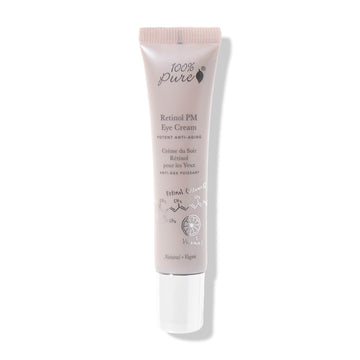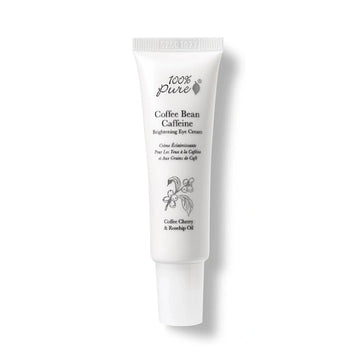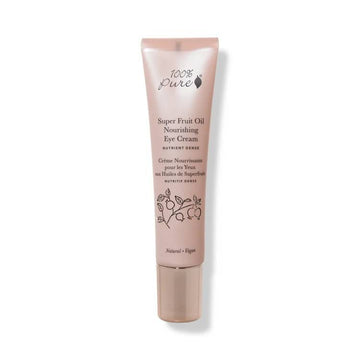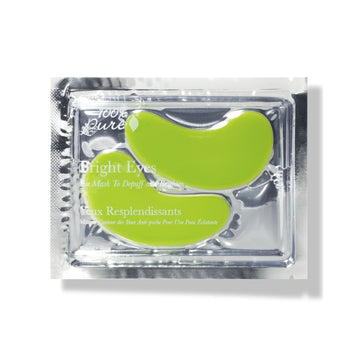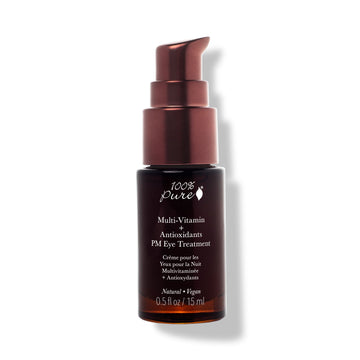Identifying the root causes and lifestyle habits of under-eye circles - plus the best natural eye creams to banish dark circles
Posted on March 26, 2025 Written by: 100% PURE®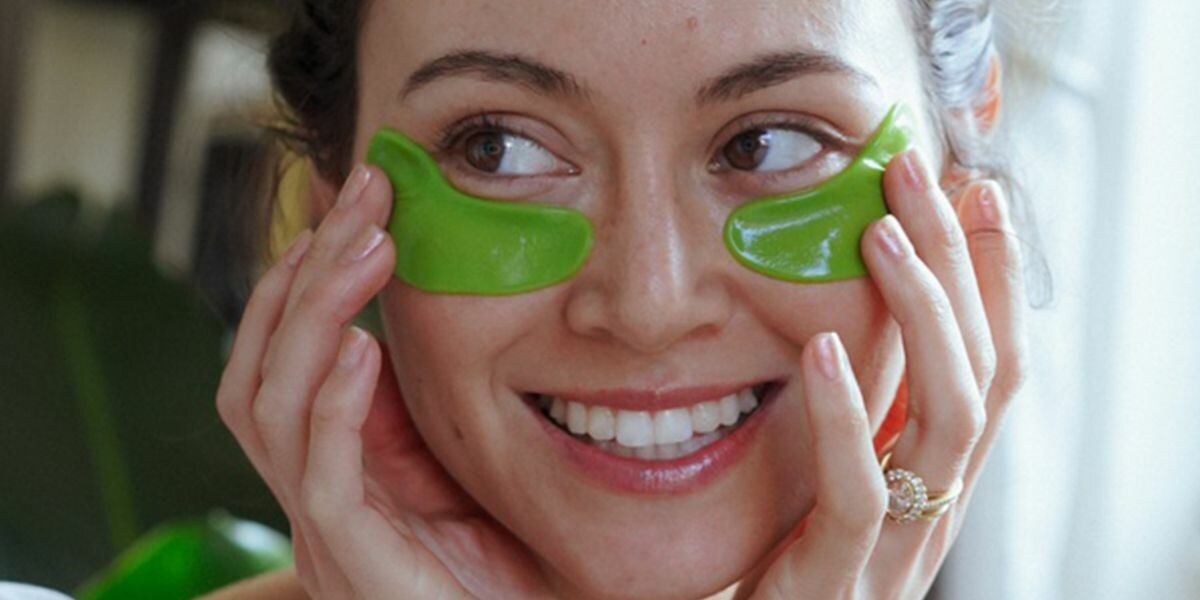
Nobody wants to wake up and face the day looking like a bad impression of a panda. While those snuggly bamboo lovers can rock the dark patches, we’re not quite so lucky. When it’s not possible to log a full night’s sleep or dodge ‘you look tired’ comments, there can be a light at the end of the tunnel.
Enter natural eye creams: the secret to wide-eyed peepers. Follow along as we spy with our little eye treatments for under-eye circles plus the best eye creams that will send those pesky dark circles packing back to those cute, black and white bears.
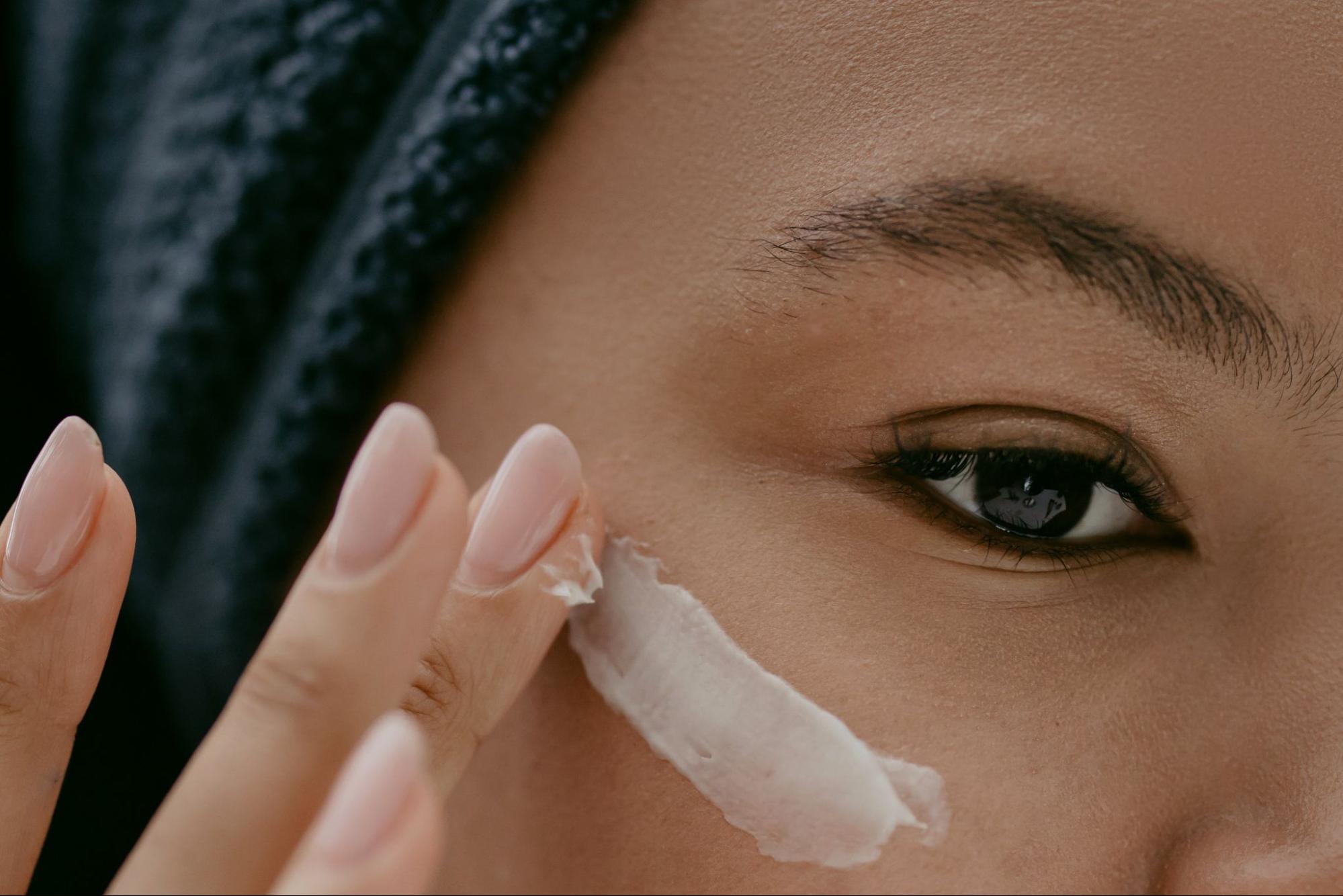
If our eyes are the windows to our souls, we sure don’t want them giving all our secrets away! Though most of us associate sleep deprivation with discoloration under the eyes, the truth is those dismal dark circles are caused by a myriad of factors.
Let’s outline some of the most common causes of under-eye circles, so you can determine the best treatment option:
Lack of sleep
When you don’t get enough sleep (7 - 9 hours per night for most adults), fluid can build up underneath your eyes, causing the puffiness and discoloration that we associate with dark circles. If you’re experiencing under-eye circles because of a lack of sleep, the good news (albeit a challenge for some of us) is that you may be able to reverse the problem by getting into a regular sleep cycle.
Eye Strain
If you work in front of a computer or watch hours of television daily, you may be experiencing eye strain, which can lead to dark circles and hurt your vision. When your eyes become strained, the blood vessels enlarge under the skin, leading to discoloration of the area around your eyes.
Dehydration
Milk doesn’t just do the body good – adequate water intake does too! Dehydration can cause your under-eye area to become dull, hollow-looking, and discolored. And, if you find that you do drink plenty of water, perhaps it’s the other beverages - caffeine, alcohol, and other diuretics - you indulge in that could be to blame.
Hormonal fluctuations
Pregnant and menstruating women may also find that they experience dark circles underneath their eyes. If you often experience under-eye circles when you’re on your cycle, you may want to discuss this issue with a doctor, as in rare cases, there may be an underlying medical condition, such as iron deficiency or thyroid disorder causing the discoloration.
Newsletter Subscribe
for more blog updates and exclusive discounts
Age and genetic factors
As your skin matures, losing some of its natural strength and elasticity, it becomes more prone to dark circles. The delicate skin covering the under-eye area is also prone to becoming thinner and losing volume, which then leads to more obvious dark shadows.
Meanwhile, certain genetic factors may also make some individuals more prone to dark circles throughout their lives.
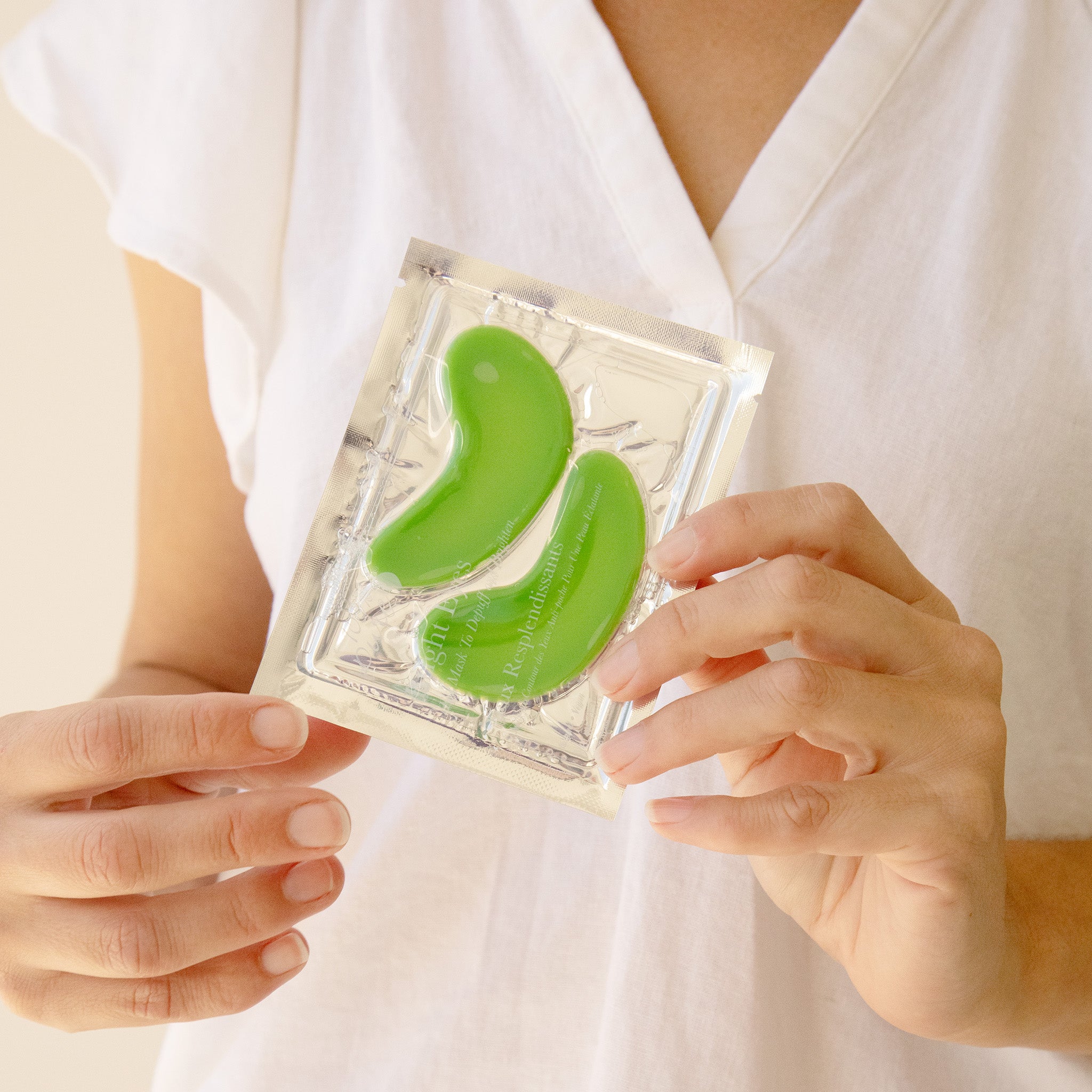
Our eyes are busy every second of the day. They can convey love, laughter, joy -- and unfortunately, dark circles. To ensure our precious peepers are presenting their best selves, it’s important to give the delicate eye area the TLC it needs and deserves by making some simple lifestyle adjustments.
Establish a regular sleep cycle
If you have trouble falling asleep at night, try stopping your screen time about an hour before bedtime. Focus on a relaxing activity that helps you unwind, such as reading or meditating. Make sure to get enough physical activity and sunlight during the day, and to eat your last meal at least 2-3 hours before going to sleep.
You can also help to revitalize your under-eye area while you sleep with our Retinol PM Eye Cream. This nourishing formula promotes production and boosts skin elasticity and firmness. It also features skin-plumping hyaluronic acid, vitamin E to deeply moisturize skin, and a blend of antioxidant-rich extracts and oils to repair daily damage and brighten skin.
Reduce eye strain
Try to take regular breaks from any screen time. If you wear glasses or contact lenses, visit your eye doctor annually to keep your prescription up-to-date. Blue-light blocking glasses are another great way to minimize eye strain and overexposure to sleep-disrupting blue light.
You can also counter the dark circle side-effects of eye strain using our Coffee Bean Caffeine Eye Cream, which harnesses a triple dose of stimulating caffeine content - green coffee extract, green tea, and coffee cherry - to reduce puffiness and promote skin brightness.
Deemed the best eye cream for dark circles, Coffee Bean Caffeine Eye Cream boosts circulation and lessens the fluid retention which causes puffiness. Vitamin E and nourishing rosehip oil deeply nourish delicate, dehydrated skin for bright and youthful eyes.
Drink plenty of water
We recommend keeping your skin cells quenched and plumped to their max by drinking plenty of water each day. It’s important to hydrate your under-eye area with a natural eye cream like our Super Fruit Oil Nourishing Eye Cream. This dual-action formula features nourishing super fruit oils that help repair and protect your precious skin while smoothing away fine lines and flakey, dry skin.
This eye cream is named for its high concentration of antioxidant-rich ingredients. Pomegranate fights sun damage and evens skin tone. Acai oil provides hydration and potent anti-aging benefits, while acerola supports collagen production in the skin.
‘Mask’ hormonal fluctuations
If you’re pregnant or on your menstrual cycle and looking for a little relief for your under-eye area, we recommend treating yourself to our Bright Eyes Masks. These gentle, cooling masks are the perfect solution to deeply quench thirsty skin, all while you sit back and let the eye mask do all the work.
Not only are these handy masks fun to use, but they can also be an incredibly skin-brightening treatment for your skin. With its soothing cucumber hydrosol and the triple boost of caffeine via green coffee beans, green tea, and yerba mate, your eyes are going to depuff and send dark circles packing.
Reduce the signs of aging
As your skin matures, losing some of its natural strength and elasticity, it becomes more prone to under-eye circles. Our Multi-Vitamin + Antioxidants PM Eye Treatment is an excellent first line of defense against dark circles, as well as some of the other signs of skin aging like fine lines, wrinkles, and discoloration.
This powerful formula is packed with potent ingredients like vitamin C and retinol, plus antioxidant-rich ingredients. This revolutionary oil-based formula is packed with the best vitamins for the skin and draws upon nutrient-dense oils from jojoba, avocado, rosehip, and green tea to enhance suppleness in the skin.
Now that you can identify the common causes of under-eye circles, it’s time to release you into the wilds of the world – and not with the pandas - armed with this knowledge. Using a natural eye cream and of course, improving some lifestyle habits may help you to get rid of dark circles for good.
FAQs: Understanding & Treating Dark Circles Under Your Eyes
1. What are the main causes of dark circles under the eyes?
Dark circles can be triggered by multiple factors, including:
-
Lack of Sleep: Not getting enough rest (7-9 hours per night) can lead to fluid retention under the eyes, causing puffiness and discoloration.
-
Eye Strain: Staring at screens for extended periods enlarges the blood vessels around the eyes, creating a darker appearance.
-
Dehydration: A lack of water can cause the skin under your eyes to become dry, making dark circles more prominent.
-
Aging: As we age, skin becomes thinner, making blood vessels more visible, which contributes to the appearance of dark circles.
-
Genetics: Some people naturally have more pigment or thinner skin under their eyes, making them more prone to dark circles.
-
Hormonal Changes: Pregnancy, menstruation, and iron deficiency can contribute to under-eye discoloration.
The best way to reduce dark circles is by addressing these underlying causes and using hydrating, antioxidant-rich eye creams like Coffee Bean Caffeine Eye Cream to boost circulation and brighten the under-eye area.
2. How does eye strain contribute to dark circles, and how can I prevent it?
Eye strain occurs when you spend long hours looking at screens (computer, phone, TV), causing enlarged blood vessels and darkened under-eye skin. Over time, this results in tired, puffy eyes and discoloration.
To prevent eye strain:
- Follow the 20-20-20 rule: Every 20 minutes, look at something 20 feet away for 20 seconds.
- Use blue light-blocking glasses to reduce strain from digital screens.
- Take regular breaks and blink more frequently to prevent eye fatigue.
- Apply an eye cream with caffeine like Coffee Bean Caffeine Eye Cream, which helps shrink blood vessels and reduce discoloration.
3. What’s the best eye cream for dark circles and puffiness?
The best eye cream depends on your specific concerns:
-
For dark circles: Multi-Vitamin + Antioxidants PM Eye Treatment contains vitamin C & retinol, which brighten the skin and boost collagen production to reduce pigmentation.
-
For puffiness & fluid retention: Coffee Bean Caffeine Eye Cream with green tea and coffee extracts reduces swelling and boosts circulation.
-
For hydration & aging skin: Super Fruit Oil Nourishing Eye Cream deeply hydrates and smooths fine lines with acai, pomegranate, and acerola extracts.
If you’re looking for an instant refresh, Bright Eyes Masks work wonders by de-puffing and revitalizing tired eyes within minutes.
4. How does aging contribute to dark circles, and what’s the best treatment?
As we age, our skin naturally loses collagen and elasticity, making it thinner and more prone to sagging and pigmentation. This can enhance the appearance of dark shadows and hollows under the eyes.
To combat aging-related dark circles:
- Use a retinol-infused eye cream like Multi-Vitamin + Antioxidants PM Eye Treatment to stimulate collagen production and improve skin thickness.
- Apply an antioxidant-rich eye cream like Super Fruit Oil Nourishing Eye Cream to protect the skin from free radical damage and restore hydration.
- Stay hydrated and eat a collagen-boosting diet with foods rich in vitamin C, omega-3s, and antioxidants.
For immediate hydration, apply an overnight eye mask or a rich eye treatment balm before bed.
5. Can diet and lifestyle changes help reduce dark circles?
Yes! Your diet and lifestyle choices play a significant role in the appearance of dark circles.
Lifestyle Tips to Reduce Dark Circles:
✔ Stay Hydrated: Drink at least 8 glasses of water daily to keep skin plump and reduce hollowness under the eyes.
✔ Eat Iron-Rich Foods: Leafy greens, lentils, and lean meats can help combat anemia-related dark circles.
✔ Limit Caffeine & Alcohol: These act as diuretics, leading to dehydration and making dark circles more prominent.
✔ Get Enough Sleep: Aim for 7-9 hours per night to prevent fluid retention and puffiness.
✔ Reduce Salt Intake: High sodium can lead to water retention, worsening under-eye swelling.
Bonus Tip: Apply a cool compress or cold tea bags under the eyes for 10 minutes to reduce puffiness and refresh the skin.
Final Thoughts: Bright, Well-Rested Eyes Are Possible!
Dark circles may seem unavoidable, but with the right skincare routine and lifestyle habits, you can dramatically reduce their appearance. The key is to hydrate, protect, and nourish your under-eye skin with natural, antioxidant-rich ingredients.
Using 100% PURE’s gentle, plant-based eye care products—like Coffee Bean Caffeine Eye Cream, Super Fruit Oil Nourishing Eye Cream, and Multi-Vitamin + Antioxidants PM Eye Treatment—can help revitalize tired eyes, reduce puffiness, and brighten dark circles naturally.
With a little self-care and the right eye cream, you can say goodbye to panda eyes and hello to refreshed, youthful-looking skin! ✨
- Tags: March-2025, Skin Care
We carefully hand-select products based on strict purity standards, and only recommend products we feel meet this criteria. 100% PURE™ may earn a small commission for products purchased through affiliate links.
The information in this article is for educational use, and not intended to substitute professional medical advice, diagnosis, or treatment and should not be used as such.












